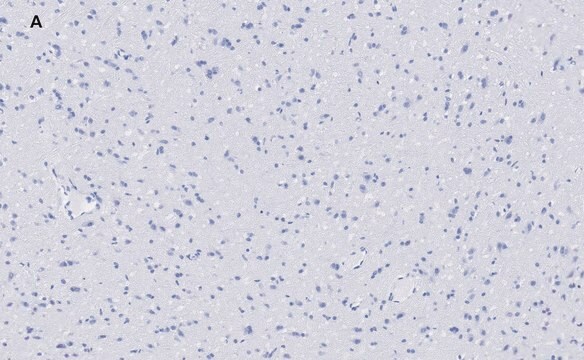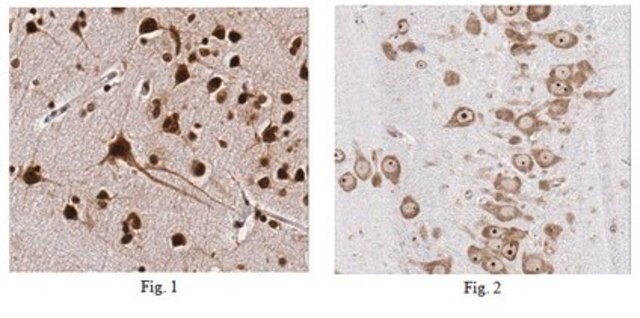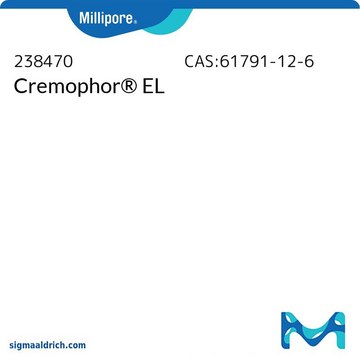ABN1647
Anti-Vesicular Glutamate Transporter 1 Antibody
rabbit polyclonal
Synonim(y):
Vesicular glutamate transporter 1, Brain-specific Na(+)-dependent inorganic phosphate cotransporter, Solute carrier family 17 member 7
About This Item
Polecane produkty
Nazwa produktu
Anti-VGluT1, from rabbit
pochodzenie biologiczne
rabbit
Poziom jakości
forma przeciwciała
unpurified
rodzaj przeciwciała
primary antibodies
klon
polyclonal
reaktywność gatunkowa
mouse, human, rat
reaktywność gatunkowa (przewidywana na podstawie homologii)
bovine (based on 100% sequence homology)
opakowanie
antibody small pack of 25 μL
metody
immunoautoradiography: suitable
immunofluorescence: suitable
immunohistochemistry: suitable
western blot: suitable
izotyp
IgG
numer dostępu NCBI
numer dostępu UniProt
Warunki transportu
ambient
docelowa modyfikacja potranslacyjna
unmodified
informacje o genach
human ... SLC17A7(57030)
Opis ogólny
Specyficzność
Immunogen
Zastosowanie
Immunohistochemistry Analysis: A representative lot detected VGLUT1 in prefrontal cortex of a representative control subject and AD patient (Kashani, A., et. al. (2008). Neurobiol Aging. 29(11):1619-30).
Western Blotting Analysis: A representative lot detected VGLUT1 in glutamate transporter 1 in rat and human putamen extracts (Kashani, A., et. al. (2007). Neurobiol Agining 28(4):568-78) and prefrontal cortex of controls, MCI, early stage Alzheimer (Kashani, A., et. al. (2008). Neurobiol Aging. 29(11):1619-30).
Immunofluorescence Analysis: A representative lot detected VGLUT1 in mouse striatum and hippocampus tissue (Courtesy of Dr.Salah el mestikawy PhD, at DR1 CNRS (CENTRE NATIONAL DE LA RECHERCHE SCIENTIFIQU - SATT LUTECH).
Immunofluorescence Analysis: A representative lot detected VGLUT1 in rat striatum (Herzog, E., et. al. (2001). J Neurosci. 21(22):RC181).
Immunoautoradiography Analysis: A representative lot detected VGLUT1 in coronal sections of frontal rat brain (Herzog, E., et. al. (2004). Neuroscience. 123(4):983-1002) and rat brain sagittal sections (Herzog, E., et. al. (2001). J Neurosci. 21(22):RC181).
Western Blotting Analysis: A representative lot detected VGLUT1 in BON cells stably expressing VGLUT1 (Herzog, E., et. al. (2001). J Neurosci. 21(22):RC181).
Neuroscience
Jakość
Western Blotting Analysis: A 1:1,000 dilution of this antibody detected VGLUT1 in 20 µg of mouse brain tissue lysate.
Opis wartości docelowych
Postać fizyczna
Przechowywanie i stabilność
Oświadczenie o zrzeczeniu się odpowiedzialności
Nie możesz znaleźć właściwego produktu?
Wypróbuj nasz Narzędzie selektora produktów.
Kod klasy składowania
12 - Non Combustible Liquids
Klasa zagrożenia wodnego (WGK)
WGK 1
Temperatura zapłonu (°F)
Not applicable
Temperatura zapłonu (°C)
Not applicable
Certyfikaty analizy (CoA)
Poszukaj Certyfikaty analizy (CoA), wpisując numer partii/serii produktów. Numery serii i partii można znaleźć na etykiecie produktu po słowach „seria” lub „partia”.
Masz już ten produkt?
Dokumenty związane z niedawno zakupionymi produktami zostały zamieszczone w Bibliotece dokumentów.
Klienci oglądali również te produkty
Nasz zespół naukowców ma doświadczenie we wszystkich obszarach badań, w tym w naukach przyrodniczych, materiałoznawstwie, syntezie chemicznej, chromatografii, analityce i wielu innych dziedzinach.
Skontaktuj się z zespołem ds. pomocy technicznej











